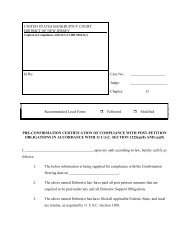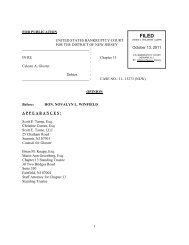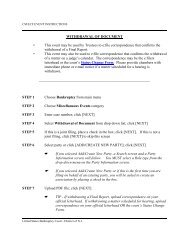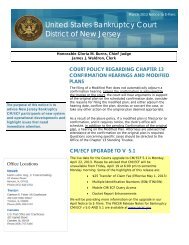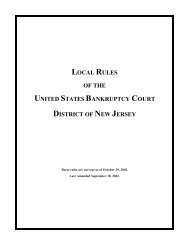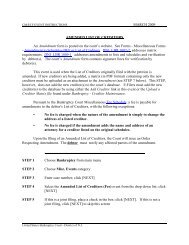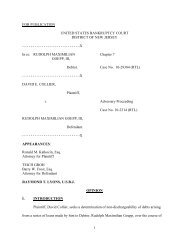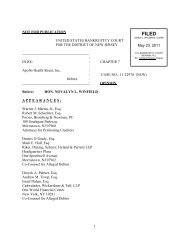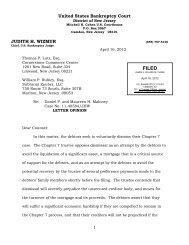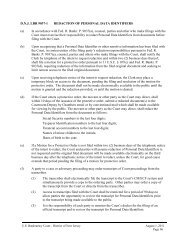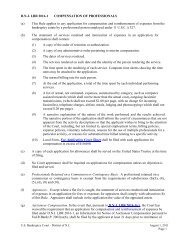In re Celentano Opinion, case no. - United States Bankruptcy Court ...
In re Celentano Opinion, case no. - United States Bankruptcy Court ...
In re Celentano Opinion, case no. - United States Bankruptcy Court ...
You also want an ePaper? Increase the reach of your titles
YUMPU automatically turns print PDFs into web optimized ePapers that Google loves.
This matter initially came befo<strong>re</strong> the court on the Trustee’s motion to compel the Debtorsto provide access to the Debtors’ <strong>re</strong>sidence. The Debtors <strong>re</strong>sponded to the Trustee’s motion witha cross-motion to compel abandonment of the Debtors’ <strong>re</strong>sidence. The court grants the Trustee’smotion and denies the Debtors’ motion.JURISDICTIONThis court has jurisdiction to consider this matter pursuant to 28 U.S.C. §§ 1334 and157(a) and the Standing Order of Refe<strong>re</strong>nce issued by the <strong>United</strong> <strong>States</strong> District <strong>Court</strong> for theDistrict of New Jersey on July 23, 1984. These motions a<strong>re</strong> co<strong>re</strong> proceedings under 28 U.S.C. §157(b)(2)(A).STATEMENT OF FACTSOn April 28, 2010 (the “Petition Date”), Gaeta<strong>no</strong> <strong>Celenta<strong>no</strong></strong> (“Mr. <strong>Celenta<strong>no</strong></strong>”) andCaterina <strong>Celenta<strong>no</strong></strong> (collectively, “Debtors”) filed for <strong>re</strong>lief under Chapter 7 of the <strong>Bankruptcy</strong>Code. On April 30, 2010, the <strong>United</strong> <strong>States</strong> Trustee appointed Steven P. Kartzman (“Trustee”)as the <strong>case</strong> trustee and he has continued as the trustee since that date.It appears that the Debtors’ need for Chapter 7 <strong>re</strong>lief <strong>re</strong>sulted from Mr. <strong>Celenta<strong>no</strong></strong>’sparticipation with th<strong>re</strong>e other individuals in a <strong>re</strong>al estate development company k<strong>no</strong>wn as War<strong>re</strong>n8, LLC. <strong>In</strong> furtherance of its development efforts, in September 2006 War<strong>re</strong>n 8, LLC obtained aconstruction loan from Two Rivers Community Bank f/k/a Town Bank (“TRCB”) in the amountof $7,486,000. As part of the security for the construction loan, Mr. <strong>Celenta<strong>no</strong></strong> and the otherth<strong>re</strong>e members of War<strong>re</strong>n 8, LLC gave TRCB personal guaranties, secu<strong>re</strong>d by mortgages on their
espective <strong>re</strong>sidences. At some point in the development project War<strong>re</strong>n 8, LLC was <strong>no</strong>t able to<strong>re</strong>main cur<strong>re</strong>nt on the construction loan, and according to Debtors’ counsel, the outstanding loanbalance approximated $4,300,000 at the time of default. Ultimately, War<strong>re</strong>n 8, LLC filed aChapter 11 <strong>case</strong> and all four members of that entity filed individual Chapter 7 <strong>case</strong>s.<strong>In</strong> its Chapter 11 <strong>case</strong>, War<strong>re</strong>n 8, LLC and TRCB ente<strong>re</strong>d into a Cash CollateralAg<strong>re</strong>ement, which provided in part that TRCB would ag<strong>re</strong>e to modify and/or eliminate theliabilities of the members of War<strong>re</strong>n 8, LLC as guarantors if the members could meet certainbenchmarks for the marketing, sale and development of the War<strong>re</strong>n 8, LLC project. Mr.<strong>Celenta<strong>no</strong></strong> advises that this ag<strong>re</strong>ement was subsequently incorporated into the War<strong>re</strong>n 8, LLCChapter 11 Plan. <strong>In</strong> fact, as <strong>re</strong>flected in §16.3 of the November 9, 2010 Order Finally ApprovingDisclosu<strong>re</strong> Statement and Confirming Debtor’s Chapter 11 Plan, as Modified, the personalliability of the members as guarantors was <strong>re</strong>duced to $250,000. Section 16.3 further providedthat all mortgages would be discharged on <strong>re</strong>ceipt of $250,000 by TRCB. (Gaeta<strong>no</strong> <strong>Celenta<strong>no</strong></strong>Affidavit, Ex. K)This substantial elimination of the obligation to TRCB is the primary <strong>re</strong>ason for thedueling motions befo<strong>re</strong> the court. At the time that the Debtors filed their Chapter 7 petition theyidentified ownership of a personal <strong>re</strong>sidence at 1700 Boulevard, Westfield, New Jersey(“Boulevard Property”) and a pa<strong>re</strong>ntal <strong>re</strong>sidence at 53 Renaissance Boulevard, Franklin, NewJersey (“Renaissance Property”). The Boulevard Property was scheduled at a value of $830,000,with the secu<strong>re</strong>d claim valued at $830,000. Schedule D identified Homecomings Financial as thefirst mortgagee on the Boulevard Property, with its claim being fully secu<strong>re</strong>d. TRCB wasidentified as the holder of a collateral mortgage in the amount of $4,300,000, with an unsecu<strong>re</strong>dportion of $3,883,472. The Renaissance Property was identified as subject to a Use &3
Occupancy Ag<strong>re</strong>ement in favor of Mr. <strong>Celenta<strong>no</strong></strong>’s pa<strong>re</strong>nts and valued at $61,000, with thesecu<strong>re</strong>d claim valued at $61,000. 1Schedule D identified Chase Home Finance, LLC as holdinga mortgage on the Renaissance Property in the amount of $218,000, with an unsecu<strong>re</strong>d portion of$157,000. The Debtors also scheduled unsecu<strong>re</strong>d claims in the amount of $14,451,576.44.Following the filing of a Notice of Assets by the Trustee on November 15, 2011, proofs of claimtotaling $2,803,207.60 we<strong>re</strong> filed.From the court’s <strong>re</strong>view of the docket, the papers filed in support of both motions and thearguments of counsel, it appears that the issue of whether the Debtors’ <strong>case</strong> contained assetsavailable for liquidation was a subject of thorough investigation by the Trustee from the outset.For example, six months after the Petition Date, in October 2010, the Trustee abandoned Mr.<strong>Celenta<strong>no</strong></strong>’s inte<strong>re</strong>sts in th<strong>re</strong>e diffe<strong>re</strong>nt limited liability companies after determining that <strong>no</strong> valuein those entities existed for the bankruptcy estate. <strong>In</strong> February 2011, in <strong>re</strong>sponse to the inquiryfrom the <strong>Bankruptcy</strong> Clerk’s office <strong>re</strong>garding <strong>case</strong> status, the Trustee <strong>re</strong>sponded that Mr.<strong>Celenta<strong>no</strong></strong> had inte<strong>re</strong>sts in a number of entities and that the Trustee had <strong>no</strong>t yet completed hisinvestigation. The Trustee’s assessment of the value of the Boulevard Property was completedonly on October 20, 2011, when the Trustee <strong>re</strong>ceived confirmation from counsel for TRCB thatthe guaranty and mortgage had been <strong>re</strong>duced. Importantly, it was only in June 2011 that theTrustee learned of the potential <strong>re</strong>duction of the TRCB obligation to $250,000. The Trusteeclaims that at <strong>no</strong> time prior to June 2011 had the Debtors disclosed that the guaranty andmortgage we<strong>re</strong> subject to <strong>re</strong>duction. The Trustee filed a Notice of Assets in November 2011.Equally, it appears that the issue of whether the Boulevard Property and/or theRenaissance Property have sufficient equity to make a sale of either property beneficial for1 Mr. <strong>Celenta<strong>no</strong></strong>’s father passed away prior to the commencement of this bankruptcy <strong>case</strong>.4
c<strong>re</strong>ditors has been a debated subject between the Trustee and Debtors’ counsel. The Trusteemaintains that the bankruptcy estate should benefit from the <strong>re</strong>duction of the TRCB mortgage to$250,000. The Trustee estimates the approximate equity available to the bankruptcy estate fromthe sale of the Boulevard Property as follows:$830,000 Fair Market Value(50,000) Cost of Sale(400,000) First Mortgage(250,000) TRCB Mortgage__________________________________________$130,000 EquityThe Debtors’ position with <strong>re</strong>gard to the existence of equity in the Boulevard Propertyhas been th<strong>re</strong>efold. First, the Debtors’ counsel argued that the <strong>re</strong>duction in the TRCB guarantyand mortgage to $250,000 was likely to be vitiated by the inability of the members of War<strong>re</strong>n 8,LLC to pay that sum, and that <strong>no</strong>n-payment would cause the TRCB obligation to “jump back to$1.2 million.” (3/15/12 Steven P. Kartzman Certification, Ex. A) But, subsequent conversationsbetween the Trustee and counsel for TRCB confirmed that the TRCB obligation subject to Mr.<strong>Celenta<strong>no</strong></strong>’s guaranty and the TRCB mortgage <strong>re</strong>mained at $250,000. That amount is <strong>re</strong>flectedin the secu<strong>re</strong>d proof of claim filed by TRCB on February 10, 2012. Thus, the Debtors’ counselhas <strong>no</strong>t continued to advocate this position.Alternatively, counsel for the Debtors and the Debtors urge the court to find that theBoulevard Property and the secu<strong>re</strong>d claims against the property should be valued as of thePetition Date. Under this approach the Boulevard Property has a value of $830,000 with secu<strong>re</strong>dclaims totaling $4,713,472, leaving negative equity of $3,883,472. Based on this computation,the Debtors urge that the Trustee should be compelled to abandon the Boulevard Property underMr. <strong>Celenta<strong>no</strong></strong>’s mother continues to occupy the Renaissance Property.5
§ 554(b) because it is of “inconsequential value and benefit to the estate.” 11 U.S.C. § 554(b).The Debtors contend that the court should <strong>no</strong>t consider the improvement in the value of theBoulevard Property that <strong>re</strong>sulted from the post-filing <strong>re</strong>duction of the TRCB loan to $250,000because the Debtors’ assets and liabilities should be viewed as a “snapshot” on the Petition Date.Lastly, Debtors’ counsel argued that the <strong>re</strong>duction in the TRCB mortgage <strong>re</strong>sulted from servicesperformed by Mr. <strong>Celenta<strong>no</strong></strong> and should be conside<strong>re</strong>d postpetition earnings and excepted fromestate property.The Debtors’ argument in support of abandonment of the Renaissance Property <strong>re</strong>sts onthe fact that the property is in an age-<strong>re</strong>stricted development, and that it is subject to a Use andOccupancy Ag<strong>re</strong>ement in favor of Mr. <strong>Celenta<strong>no</strong></strong>’s mother. Based on these facts, the Debtorshave submitted an appraisal that posits a fair market value of the Debtors’ inte<strong>re</strong>st in theRenaissance Property of $61,000 as of the Petition Date. <strong>In</strong> addition, Debtors provide anattorney’s opinion letter opining that the Use and Occupancy Ag<strong>re</strong>ement is in the natu<strong>re</strong> of a lifeestate and that the open occupation of the Renaissance Property by Mr. <strong>Celenta<strong>no</strong></strong>’s mothercould constitute <strong>no</strong>tice to a subsequent purchaser. Finally, Mr. <strong>Celenta<strong>no</strong></strong> supplied asupplemental affidavit in which he avers that his pa<strong>re</strong>nts contributed the sum of $240,081.74 tothe purchase of the property and <strong>re</strong>duction of the mortgage. He also stated that his pa<strong>re</strong>ntsalways paid the expenses of ownership and use.The Trustee views the available equity in the Renaissance Property very diffe<strong>re</strong>ntly. TheTrustee calculates available equity in the Renaissance Property as follows:$ 380,000 Fair Market Value(24,000) Cost of Sale(156,000) Mortgage__________________________________$ 200,000 Equity6
The Trustee completely discounts the analysis provided by the Debtors, contending that the Useand Occupancy Ag<strong>re</strong>ement was never <strong>re</strong>corded and that under the Trustee’s strong-arm powersthe transfer can be avoided because of the Trustee’s status as a bona fide purchaser.Alternatively, the Trustee argues that avoidance is possible because the Debtors’ granting of theUse and Occupancy Ag<strong>re</strong>ement was a fraudulent transfer. The Trustee asserts that when the Useand Occupancy Ag<strong>re</strong>ement was given the Debtors we<strong>re</strong> insolvent, the transfer was to insidersand the Debtors did <strong>no</strong>t <strong>re</strong>ceive value in exchange for the transfer. Under both arguments theTrustee does <strong>no</strong>t <strong>re</strong>cognize alleged life estate in favor of Mr. <strong>Celenta<strong>no</strong></strong>’s mother and maintainsthat the fair market value of the Renaissance Property is $380,000.DISCUSSIONThe ultimate issue p<strong>re</strong>sented for <strong>re</strong>solution by the competing motions is whether theDebtors have sufficiently demonstrated that the Boulevard Property and the RenaissanceProperty a<strong>re</strong> of such inconsequential value and benefit to the estate that the Trustee must becompelled to abandon the properties under § 554(b) of the <strong>Bankruptcy</strong> Code. If the propertiesmust be abandoned, the<strong>re</strong> is <strong>no</strong> need to consider the Trustee’s motion to compel access to theDebtors’ property.A. Trustee’s Exercise of Disc<strong>re</strong>tionThe duties of a Chapter 7 trustee a<strong>re</strong> set forth in § 704 of the <strong>Bankruptcy</strong> Code. Pertinentto the matter at hand, under § 704(a)(1) the Trustee is obligated to “collect and <strong>re</strong>duce to moneythe property of the estate ... and close such estate as expeditiously as is compatible with the bestinte<strong>re</strong>st of parties in inte<strong>re</strong>st,” and under § 704(a)(4) to “investigate the financial affairs of the7
debtor.” A trustee has substantial disc<strong>re</strong>tion in performance of these duties. <strong>In</strong> <strong>re</strong> CultAwa<strong>re</strong>ness Network, <strong>In</strong>c., 205 B.R. 575, 579 (Bankr. N.D. Ill. 1997). Likewise, a trustee’sdecision to abandon assets of the estate is disc<strong>re</strong>tionary. Id.; see also Morgan v. K.C. Machine &Tool Co. (<strong>In</strong> <strong>re</strong> K.C. Machine & Tool Co.), 816 F.2d 238, 246 (6th Cir. 1987); <strong>In</strong> <strong>re</strong> Slack, 290B.R. 282, 284 (Bankr. D.N.J. 2003). <strong>In</strong> the matter befo<strong>re</strong> the court it appears that the Trusteeacted with appropriate diligence in investigating the affairs of the Debtors. As indicated in his<strong>re</strong>ply to the Clerk’s Office February 2011 inquiry, the Trustee did <strong>no</strong>t move to close the estatebecause he continued to examine Mr. <strong>Celenta<strong>no</strong></strong>’s business affairs. Most importantly, with<strong>re</strong>gard to determining the value of the estate’s <strong>re</strong>al property, the Trustee confirmed the <strong>re</strong>ductio<strong>no</strong>f the TRCB mortgage in only October 2011. Thus, the Trustee’s filing of a Notice of Assets inNovember 2011 was appropriate and the court does <strong>no</strong>t discern any p<strong>re</strong>judice to the Debtors with<strong>re</strong>gard to the Trustee’s administration of the <strong>case</strong>.B. Proper Date for Valuation of Estate PropertyThe party seeking to compel the trustee to abandon estate property bears the burden ofestablishing a prima facie <strong>case</strong> that “the property is of inconsequential value and benefit to theestate.” <strong>In</strong> <strong>re</strong> Paolella, 79 B.R. 607, 610 (Bankr. E.D. Pa. 1987)(citing <strong>In</strong> <strong>re</strong> Brannan, 5 B.R.505 (D.V.I. 1980)); <strong>In</strong> <strong>re</strong> DiDario, 232 B.R. 311, 313 (Bankr, D.N.J. 1999). The trustee may<strong>re</strong>but the prima facie <strong>case</strong> by showing that the estate has equity in the property, “including interalia proof that the secu<strong>re</strong>d c<strong>re</strong>ditor’s liens a<strong>re</strong> or can be subordinated to an inte<strong>re</strong>st of thetrustee.” Id. (citing <strong>In</strong> <strong>re</strong> Kelly, 21 B.R. 495 (Bankr. W.D. Va. 1982)).<strong>In</strong> support of their motion to compel abandonment of the Boulevard Property, the Debtorsargue that both properties should be valued as of the Petition Date. Valuation as of the PetitionDate would be beneficial to the Debtors because the TRCB obligation had <strong>no</strong>t yet been <strong>re</strong>duced8
to $250,000. The Debtors <strong>re</strong>ly on a number of <strong>case</strong>s that find that the Petition Date is theappropriate date for valuing estate property, however, these <strong>case</strong>s a<strong>re</strong> factually inapposite to thep<strong>re</strong>sent matter. The <strong>case</strong>s highlighted by the Debtors do <strong>no</strong>t add<strong>re</strong>ss valuation of estate propertyfor purposes of determining whether property should be abandoned as having inconsequentialvalue and benefit to the estate.For example, Young v. Camelot Homes, <strong>In</strong>c. (<strong>In</strong> <strong>re</strong> Young), 390 B.R. 480 (Bankr. D. Me.2008) and Johnson v. Gen. Motors Acceptance Corp. (<strong>In</strong> <strong>re</strong> Johnson), 165 B.R. 524 (S.D. Ga.1994) chose the petition date as the date for determining valuation of estate property for purposesof complying with § 1325(a)(5). Similarly, Dean v. LaPlaya, <strong>In</strong>vs., <strong>In</strong>c. (<strong>In</strong> <strong>re</strong> Dean), 319 B.R.474 (Bankr. E.D. Va. 2004), and W. <strong>In</strong>terstate Bancorp. v. Edwards (<strong>In</strong> <strong>re</strong> Edwards), 245 B.R.917 (Bankr. S.D. Ga. 2000) found the petition date to be the appropriate date for purposes ofconfirmation of Chapter 13 plans and modification of secu<strong>re</strong>d claims under § 1322(b)(2), and a<strong>re</strong><strong>no</strong>t even dispositive <strong>re</strong>garding the time for § 1322(b)(2) purposes. Most <strong>no</strong>tably, the <strong>Court</strong> inDean specifically ack<strong>no</strong>wledged that the<strong>re</strong> is <strong>no</strong> consensus in the <strong>case</strong> law <strong>re</strong>garding the propervaluation date even for purposes of modifying secu<strong>re</strong>d claims under § 1322(b)(2). 2319 B.R. at477.Mo<strong>re</strong>over, the Chapter 7 <strong>case</strong>s cited by the Debtors – <strong>United</strong> <strong>States</strong> v. Zlogar, 126 B.R.53 (Bankr. N.D. Ill. 1991); Mays v. <strong>United</strong> <strong>States</strong> (<strong>In</strong> <strong>re</strong> Mays), 85 B.R. 955 (E.D. Pa. 1988); andCrouch v. Pioneer Fed. Sav. Bank (<strong>In</strong> <strong>re</strong> Crouch), 76 B.R. 91 (Bankr. W.D. Va. 1987) – a<strong>re</strong>particularly inapposite to the cur<strong>re</strong>nt matter because each <strong>case</strong> permitted lien-stripping under §506(a), a practice subsequently overruled in Dewsnup v. Timm, 502 U.S. 410 (1992).2 <strong>In</strong>deed this court in <strong>In</strong> <strong>re</strong> Smith, No. 05-17203, 2006 WL 4452987 (Bankr. D.N.J. April27, 2006) held that the hearing date in a Chapter 13 <strong>case</strong> for purposes of lien avoidance is the9
The Trustee cor<strong>re</strong>ctly points out that the<strong>re</strong> is <strong>no</strong> <strong>re</strong>qui<strong>re</strong>ment in § 554 and <strong>Bankruptcy</strong>Rule 6007 that limits a determination of the value of estate property or the extent of a secu<strong>re</strong>dclaim to a “snapshot” taken as of the petition date. Recognizing this, the <strong>Court</strong> in <strong>In</strong> <strong>re</strong> Siegel,204 B.R. 6, 8 (Bankr. W.D.N.Y. 1996) observed that<strong>In</strong> the balancing of burden and benefit, this <strong>Court</strong> must <strong>re</strong>cognize that values a<strong>re</strong>seldom static over time and circumstance. Even when the identification of anestate inte<strong>re</strong>st is fixed as of the date of bankruptcy filing, its value to the estatemay fluctuate during the period of estate administration. . . Section 554(b) looksgenerally to value for the estate, without focus upon the immediacy of any <strong>re</strong>turn.<strong>In</strong> Siegel, after the <strong>case</strong> had been pending for almost one year, the debtor moved to compel thetrustee to abandon the estate’s inte<strong>re</strong>st in a one-half inte<strong>re</strong>st in homestead property jointly heldwith a <strong>no</strong>ndebtor spouse. The equity in the property approximated $103,000. Id. at 7. Thedebtor asserted that the trustee could offer for sale only the debtor’s right of survivorship, whichthe debtor characterized as having speculative value, because the trustee had decided <strong>no</strong>t to seeksale of the property under § 363(h).Id. at 8. The court declined to compel abandonment,stating that the trustee could still seek to maximize a <strong>re</strong>turn for c<strong>re</strong>ditors by either considering adiscounted sale of the right of survivorship or a deferral of its sale to a later date when the wholeproperty might be sold. Id. at 9. Similarly, in the <strong>case</strong> cur<strong>re</strong>ntly befo<strong>re</strong> this court, the sale ofestate property, the Boulevard Property in particular, may produce funds sufficient to pay adividend to c<strong>re</strong>ditors.<strong>Bankruptcy</strong> Code § 506(a)(1), also indicates that the court need <strong>no</strong>t look solely to thePetition Date to value an inte<strong>re</strong>st. It di<strong>re</strong>cts that the value of a secu<strong>re</strong>d claim is determined “inlight of the purpose of the valuation and of the proposed disposition and use of such property...”11 U.S.C. § 506(a)(1). It is also well <strong>re</strong>cognized that under § 541(a)(6) postpetition app<strong>re</strong>ciationconfirmation hearing date.10
of estate property inu<strong>re</strong>s to the benefit of the bankruptcy estate. Vu v. Kendall (<strong>In</strong> <strong>re</strong> Vu), 245B.R. 644, 647-48 (9th Cir. B.A.P. 2000); Schwaber v. Reed (<strong>In</strong> <strong>re</strong> Reed), 940 F.2d 1317, 1323(9th Cir. 1991); Paolella, 85 B.R. at 977 (citing Clark v. O’Neill (<strong>In</strong> <strong>re</strong> Clark), 711 F.2d 21, 23(3d Cir. 1983)). As explained in these <strong>case</strong>s, the term “proceeds” in § 541(a)(6) is sensibly <strong>re</strong>adas encompassing postpetition inc<strong>re</strong>ases in value, <strong>re</strong>gardless of whether an inc<strong>re</strong>ase is a product ofa <strong>re</strong>duction in the amount of a lien, the passage of time or some other market event.Judge Fox’s decision in Paolella is particularly applicable to the matter befo<strong>re</strong> this court.<strong>In</strong> Paolella, the debtors similarly sought to compel the trustee to abandon the estate’s inte<strong>re</strong>st intheir <strong>re</strong>sidence. The <strong>Court</strong> framed the issue befo<strong>re</strong> it as “whether potential equity in propertyc<strong>re</strong>ated postpetition, but befo<strong>re</strong> the property is liquidated or abandoned, constitutes property ofthe estate.” Paolella, 85 B.R. at 975. Like the matter at hand, the <strong>re</strong>sidence lacked equity on thedate the Chapter 7 petition was filed. It was encumbe<strong>re</strong>d by a judgment lien in the amount of$851,946.38. Prior to the bankruptcy the debtors <strong>re</strong>ceived an offer from the judgment holderunder which it ag<strong>re</strong>ed to satisfy its judgment in <strong>re</strong>turn for payment to it of $100,000. Id. Thedebtors we<strong>re</strong> <strong>no</strong>t able to raise the money but continued to negotiate with the judgment holderpostpetition. Id. The trustee was made awa<strong>re</strong> of the negotiations. Id. Eventually, the judgmentwas sold for the sum of $125,000 to a group of <strong>re</strong>latives and friends (the “purchasers”). Id. at976.Subsequently the trustee filed a complaint against the purchasers to limit the purchasers’claim to $125,000. Id. The court determined that the<strong>re</strong> was sufficient evidence befo<strong>re</strong> itindicating that the trustee had a <strong>re</strong>asonable probability of p<strong>re</strong>vailing on his complaint andc<strong>re</strong>ating equity for the estate. Paolella, 85 B.R. at 976. As a <strong>re</strong>sult the <strong>Court</strong> held thatabandonment was <strong>no</strong>t appropriate and the debtors’ motion was denied without p<strong>re</strong>judice. Id. at11
977. The court pointed out that the fact that § 541(a)(6) includes proceeds of estate property“means that when property of the estate is sold, whatever consideration is <strong>re</strong>ceived belongs to theestate subject to the debtor’s potential exemption rights under 11 U.S.C. § 522.” Id. The <strong>Court</strong>further emphasized its conclusion, stating thatBecause sale does <strong>no</strong>t generally, if ever, occur simultaneously with formation of abankruptcy estate, § 541(a)(6) mandates that the estate <strong>re</strong>ceive the value of theproperty at the time of the sale. This value may include app<strong>re</strong>ciation or beenhanced by other circumstances c<strong>re</strong>ating equity which occur postpetition.Id. (citations omitted).The court also ack<strong>no</strong>wledged that had the judgment been satisfied after abandonment ofthe <strong>re</strong>sidence the improvement in value would have belonged to the debtors. Id. at 977. It furthercommented, however,I see <strong>no</strong>thing inequitable about a diffe<strong>re</strong>nt <strong>re</strong>sult being mandated depending onwhether abandonment has or has <strong>no</strong>t occur<strong>re</strong>d. The diffe<strong>re</strong>nt <strong>re</strong>sults a<strong>re</strong> enti<strong>re</strong>lyconsistent with the principle of allowing a bankruptcy trustee an adequateopportunity to administer property of the estate to discover whether equity isavailable. Had the trustee instigated a compromise with a secu<strong>re</strong>d c<strong>re</strong>ditor (anenti<strong>re</strong>ly appropriate action for a trustee), I do <strong>no</strong>t believe that any party wouldseriously argue that the <strong>re</strong>sulting equity would accrue to the debtor rather than tothe estate.Id. at 978. (citations omitted).Applying Paolella to the matter at hand, it is evident that the effect of the <strong>re</strong>duction of theTRCB mortgage to $250,000 prior to an abandonment of the Boulevard Property by the Trusteec<strong>re</strong>ates a potential for equity that may produce a dividend for c<strong>re</strong>ditors. If the court looks only tothe Petition Date to determine the amount of the TRCB mortgage against the Boulevard Propertythe bankruptcy estate and its c<strong>re</strong>ditors a<strong>re</strong> deprived of the opportunity to benefit from a potentialsale. Accordingly, the court <strong>re</strong>jects the Debtor’s argument that valuation is limited to a snapshotas of the Petition Date.12
C. Postpetition Employment CompensationAt the hearing, the Debtors’ counsel alternatively argued that the app<strong>re</strong>ciation in value ofthe Boulevard Property should be conside<strong>re</strong>d income from services performed by Mr. <strong>Celenta<strong>no</strong></strong>in the War<strong>re</strong>n 8, LLC bankruptcy, and the<strong>re</strong>fo<strong>re</strong> excluded from the <strong>re</strong>ach of § 541(a)(6). 3Tosupport this argument the Debtors <strong>re</strong>ly on <strong>case</strong> law c<strong>re</strong>diting the earning of stock options andseverance pay to the debtors as a <strong>re</strong>sult of their postpetition employment. The Debtors interp<strong>re</strong>tthe <strong>case</strong>s to stand for the proposition that any postpetition efforts of a debtor <strong>re</strong>sulting in earningsfor an estate should benefit the debtor.The Debtors cite various <strong>case</strong>s in which the <strong>re</strong>spective debtors maintained employmentpostpetition the<strong>re</strong>by entitling the debtors to certain stock options and severance payments that thedebtors would <strong>no</strong>t otherwise have been entitled to <strong>re</strong>ceive. See <strong>In</strong> <strong>re</strong> Allen, 226 B.R. 857, 865,867 (Bankr. N.D. Ill. 1998)(finding that the estate’s property inte<strong>re</strong>st was the contingent right toexercise a stock option that existed on the petition date but determining that the portion of theproperty inte<strong>re</strong>st attributable to the debtor’s postpetition employment is excluded from theestate). <strong>In</strong> Allen, the court found that the continued employment solely benefitted the debtorsbecause the bankruptcy estate would <strong>no</strong>t have been entitled to the stock options or severancepayments had the debtors stopped working on the petition date. Id. 867-68.He<strong>re</strong>, the Debtors argue that Mr. <strong>Celenta<strong>no</strong></strong>’s postpetition settlement negotiations withTRCB a<strong>re</strong> analogous to continued postpetition employment. The court disag<strong>re</strong>es. The court<strong>no</strong>tes that the Debtors’ Amended Statement of Financial Affairs lists two sources of income –3 Section 541(a)(6) states that the bankruptcy “estate is comprised of all the followingproperty, whe<strong>re</strong>ver located and by whomever held. . . proceeds, product, offspring, <strong>re</strong>nts, orprofits of or from property of the estate, expect such as a<strong>re</strong> earning from services performed byan individual debtor after the commencement of the <strong>case</strong>.”13
part-time teacher and Custom Service Builders, <strong>In</strong>c. (See Amend. Stmt of Fin. Affairs, DocketNo. 5) Debtors do <strong>no</strong>t list War<strong>re</strong>n 8, LLC as a source of income. Mo<strong>re</strong> importantly, Mr.<strong>Celenta<strong>no</strong></strong>’s efforts to <strong>re</strong>duce his exposu<strong>re</strong> as a member of War<strong>re</strong>n 8, LLC to a multi-milliondollar liability <strong>re</strong>flects the effort of an equity owner, <strong>no</strong>t an employee.<strong>In</strong> short, neither the facts <strong>no</strong>r the arguments advanced by the Debtors demonstrate that theBoulevard Property should be abandoned by the Trustee. To the contrary, the <strong>re</strong>duction in theTRCB mortgage demonstrates a likelihood that equity exists for the benefit of the bankruptcyestate. The existence of equity, of course, depends on the sale price and the costs of sale, as wellas whether the Debtors intend to claim their homestead exemption. The Debtors’ motion tocompel abandonment will be denied without p<strong>re</strong>judice. The Trustee’s motion to compel accessto the Boulevard Property will be granted, as it is in furtherance of his duties under § 704(a)(1)of the <strong>Bankruptcy</strong> Code.D. The Renaissance PropertyThe Renaissance Property was <strong>no</strong>t the subject of the Trustee’s motion to compel access.Nonetheless, the Debtors moved to compel its abandonment, arguing that they havedemonstrated a lack of equity in the property. The Debtors’ position, however, lacks sufficientweight to compel abandonment. As <strong>no</strong>ted in K.C. Machine & Tool, “an order compelling thetrustee’s abandonment is the exception rather than the rule.” 816 F.2d at 246. This shouldcertainly be true whe<strong>re</strong> the Trustee identifies meritorious avoidance litigation that may provideequity in property from which c<strong>re</strong>ditors may <strong>re</strong>ceive a <strong>re</strong>covery. The Trustee posits that underN.J.S.A. 46:16-1, which was <strong>re</strong>pealed effective May 1, 2012 and <strong>re</strong>placed by N.J.S.A. 46:26A-2,a deed granting a life estate is an instrument entitled to be <strong>re</strong>corded, and that as a <strong>re</strong>sult of the lifeestate he<strong>re</strong> <strong>no</strong>t being <strong>re</strong>corded it can be avoided pursuant to § 544 of the <strong>Bankruptcy</strong> Code.14
Further, the Trustee contends that the granting of the life estate was a fraudulent transfer,claiming that the Debtors we<strong>re</strong> insolvent at the time of the transfer, and that the Debtors did <strong>no</strong>t<strong>re</strong>ceive any value in <strong>re</strong>turn. The Debtors claim that defenses exist to the Trustee’s allegations.These arguments and alleged facts <strong>re</strong>qui<strong>re</strong> an adversary complaint to be filed. Fo<strong>re</strong>xample, the Debtors <strong>re</strong>ly on an attorney’s opinion letter that ack<strong>no</strong>wledges that the life estatewas un<strong>re</strong>corded, and points out that Mr. <strong>Celenta<strong>no</strong></strong>’s mother’s occupancy of the RenaissanceProperty has been constant and open since the Debtors purchased the property. The opinionletter cites to Schwoebel v. Storrie, 76 N.J. Eq. 466 (Ch. 1909) as potentially placing asubsequent purchaser on inquiry <strong>no</strong>tice. See also Caplan v. Palace Realty Co., 110 A. 584 (N.J.Ch. 1920). Further, the Trustee has <strong>no</strong>t developed facts of the alleged fraudulent transfer in thep<strong>re</strong>sent <strong>re</strong>cord but rather has me<strong>re</strong>ly suggested them. Depending on how the <strong>re</strong>cord of the as yetunfiled adversary proceeding develops, the Trustee may <strong>no</strong>t p<strong>re</strong>vail. Nevertheless, the Trusteehas outlined a plausible basis for finding equity may exist in the Renaissance Property, and thatis sufficient at p<strong>re</strong>sent for the court to deny the Debtors’ motion.CONCLUSIONPostpetition app<strong>re</strong>ciation of property values accrues to the benefit of the Chapter 7 estateprior to abandonment. The Debtors’ p<strong>re</strong>sent motion to compel the Trustee to abandon theBoulevard Property will be denied without p<strong>re</strong>judice. The Trustee’s motion to compel access tothe Boulevard Property will be granted. Because the Trustee has stated a plausible theory foravoidance of the life estate in the Renaissance Property, the Debtors’ motion to abandon thisproperty is denied without p<strong>re</strong>judice to <strong>re</strong>newal if the Trustee is <strong>no</strong>t successful in his avoidanceaction.15
16____/S/_____________________________NOVALYN L. WINFIELD<strong>United</strong> <strong>States</strong> <strong>Bankruptcy</strong> Judge




